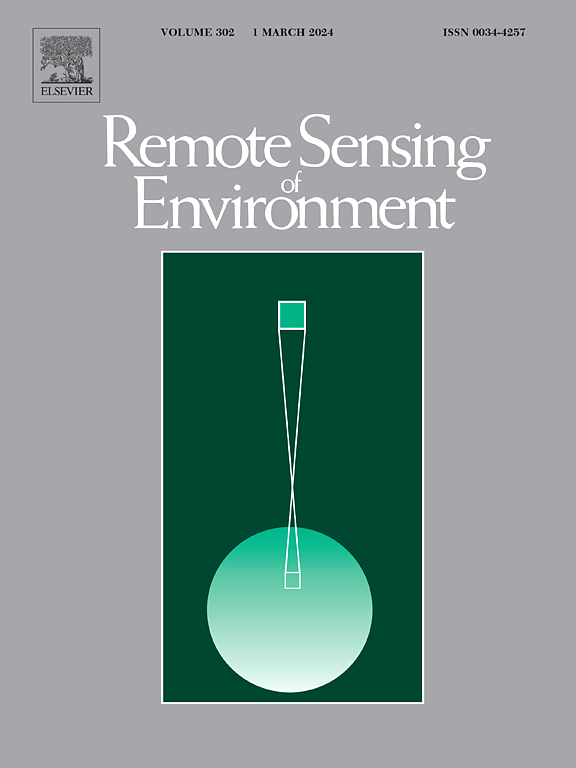基于光谱不变性理论的植被冠层反射率地形校正模型
IF 11.1
1区 地球科学
Q1 ENVIRONMENTAL SCIENCES
引用次数: 0
摘要
地形改变了冠层内的入射辐射和辐射传递(RT)过程,导致冠层双向反射因子(BRF)的变化。传统的植被冠层brf半物理地形校正(TC)方法大多依赖于简化基于物理的解析RT模型。然而,这些解析RT模型并没有对所有RT计算进行全面的参数化,导致在推导半物理TC方法时忽略了关键过程,例如多重散射过程。谱不变量理论(p-理论)通过简化RT计算,为模拟冠层brf提供了一种有效的方法。我们将p-理论扩展到斜坡地形,考虑地形诱导的入射辐射和RT过程的变化,并建立了一个冠层BRF TC模型,称为p-C方法。p-C方法不仅适用于冠层内多重散射较低的光谱波段(例如,可见光波段),也适用于近红外(NIR)波段,在近红外波段,多重散射效应可能比冠层内的可见光波段更为明显。我们使用三维RT模型DART (Discrete Anisotropic Radiative Transfer)模拟RAMI (RAdiation Transfer model Intercomparison)实验中均匀、真实冠层的BRF,并使用真实DEM (Digital Elevation model)的BRF图像来评估p-C方法,并将其与传统的经验和半物理TC方法(CC、SCS、SCS+C、DS、PLC-S和SE)进行比较。与这些方法相比,p-C方法的RMSE(均方根误差)分别降低了67%、64%、64%、85%、83%和54%。此外,将p-C方法应用于Landsat 8 OLI遥感BRF图像时,目视解译和校正后的BRF图像与当地太阳入射角之间的线性回归证实了p-C方法有效地消除了地形纹理。目前,p-C方法只考虑光照斜坡,对阴影斜坡的修正需要在未来进行研究。本文章由计算机程序翻译,如有差异,请以英文原文为准。
A model based on spectral invariant theory for correcting topographic effects on vegetation canopy reflectance
Topography alters both the incident radiation and radiative transfer (RT) processes within the canopy, leading to changes in the canopy bidirectional reflectance factor (BRF). Most traditional semi-physical terrain correction (TC) methods for vegetation canopy BRFs rely on simplifying physically-based analytical RT models. However, these analytical RT models are not comprehensively parameterized for all RT computations, leading to the neglect of crucial processes, such as multiple scattering processes during the derivation of semi-physical TC methods. The spectral invariants theory (p-theory) offers an efficient approach to model canopy BRFs by simplifying RT computations. We extended p-theory to sloping terrain, considering the variation of the terrain-induced incident radiation and RT processes, and developed a canopy BRF TC model, termed the p-C method. The p-C method applies not only to spectral bands with lower multiple scattering within the canopy (e.g., visible bands) but also to near-infrared (NIR) bands, where multiple scattering effects may be more pronounced than in the visible bands within the canopy. We used the three-dimensional RT model DART (Discrete Anisotropic Radiative Transfer) to simulate BRFs of homogeneous, realistic canopies of the RAMI (RAdiation transfer Model Intercomparison) experiment, and BRF images with real DEM (Digital Elevation Model) to evaluate the p-C method and to compare it with traditional empirical and semi-physical TC methods (CC, SCS, SCS+C, DS, PLC-S, and SE). The p-C method reduced the RMSE (root mean square error) by 67 %, 64 %, 64 %, 85 %, 83 %, and 54 % respectively over these methods. Furthermore, when applied to Landsat 8 OLI remote sensing BRF images, the p-C method effectively eliminated terrain texture, as confirmed by visual interpretation and the linear regression between the corrected BRF images and the local solar incidence angle. Currently, the p-C method only considers illuminated slopes, and corrections for shaded slopes need to be studied in the future.
求助全文
通过发布文献求助,成功后即可免费获取论文全文。
去求助
来源期刊

Remote Sensing of Environment
环境科学-成像科学与照相技术
CiteScore
25.10
自引率
8.90%
发文量
455
审稿时长
53 days
期刊介绍:
Remote Sensing of Environment (RSE) serves the Earth observation community by disseminating results on the theory, science, applications, and technology that contribute to advancing the field of remote sensing. With a thoroughly interdisciplinary approach, RSE encompasses terrestrial, oceanic, and atmospheric sensing.
The journal emphasizes biophysical and quantitative approaches to remote sensing at local to global scales, covering a diverse range of applications and techniques.
RSE serves as a vital platform for the exchange of knowledge and advancements in the dynamic field of remote sensing.
 求助内容:
求助内容: 应助结果提醒方式:
应助结果提醒方式:


